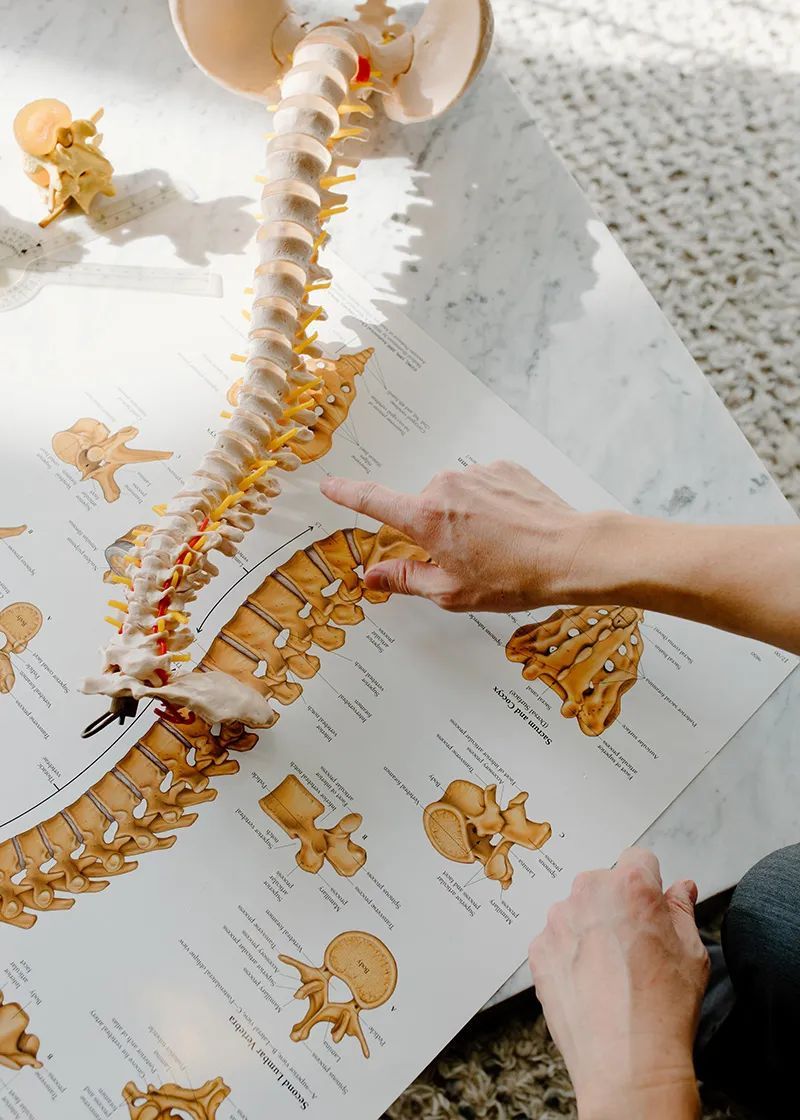Sciatica Treatment
A DEEP DIVE INTO THE CAUSES OF SCIATICA AND HOW CHIROPRACTIC CARE CAN HELP ALLEVIATE ITS SYMPTOMS.
Sciatica Treatment
A DEEP DIVE INTO THE CAUSES OF SCIATICA AND HOW CHIROPRACTIC CARE CAN HELP ALLEVIATE ITS SYMPTOMS.
WHAT IS SCIATICA?
Sciatica is a broad term used to describe pain that radiates anywhere from the lower back to the legs. This pain most commonly appears in the lower back and upper hip region, and it’s named after the sciatic nerve, which runs all the way from the lower spine to below the knee.
Despite its name, sciatica isn’t always related to a specific injury along the sciatic nerve (in fact, pain that comes from injuries to this nerve is relatively rare). Instead, it’s a general way to identify pain in the lower back and upper leg.


A CLOSER LOOK AT THE
SCIATIC NERVE
You’ve likely heard of the sciatic nerve. Not only is it located at the crucial juncture between the spine and the legs, but it’s also the largest nerve in the human body. It runs all the way from the lumbar spine (AKA the lower spine) down the glutes, hips, and all the way to below the knees on each leg.
The sciatic nerve has five main roots, all of which branch off into the left and right leg. Once these branches reach below the knee, they branch off even further into smaller offshoots that continue down the calf all the way to the ankle and foot.
SYMPTOMS OF SCIATICA
What distinguishes sciatica from general back pain? In order to be called sciatica, pain must radiate from the lower back into the legs, rather than remaining in just the lower back or just the legs. Essentially, if the pain manifests throughout the region in which the sciatic nerve is located, it is sciatica.
What Causes Sciatica?
Interestingly enough, sciatica isn’t necessarily caused by direct damage to the sciatic nerve. In fact, as we mentioned earlier, that’s actually a pretty rare cause. With that said, sciatica can have a few different causes, including:
Herniated discs in the spine
Degeneration of the spinal discs, during which they wear down and become thinner or weaker than normal
Degenerative joint diseases in the spine, like osteoarthritis
Injuries to the lower spine’
Spinal cancer
Spinal stenosis
SCIATICA RISK FACTORS

Are some people at greater risk of developing sciatica than others? The short answer is yes, although sciatica can also arise as a result of unpredictable things like accidents and injuries. If any of the following criteria apply to you, you may be at a higher risk of developing sciatica:
- Age over 50. With age comes higher degrees of wear and tear on the skeletal and nervous systems, which places people at a higher risk of sciatica.
- Being overweight or obese, which can place a greater strain on the skeletal and nervous system.
- Sedentary lifestyles, which can cause weaker muscles and place greater strain on the lower spine (especially for those who work desk jobs or otherwise spend the majority of their day sitting).
- Overexertion. On the other end of the spectrum, those with labor-intensive jobs may be placing greater strain on their spine and the nerves/muscles surrounding it.
- Illnesses that affect the bones and nerves, like arthritis, osteoporosis, and diabetes.
HOW SCIATICA
PROGRESSES
Depending on the cause of your sciatica, it can progress at varying rates and intensities. Generally speaking, the longer that sciatica goes untreated, the greater the chances that it will further devolve into more serious symptoms, including:
- Leg mobility limitations
- Numbness in the legs and/or feet
- Increasingly severe back pain
- Weakness in the lower back, glutes, and legs


TREATING SCIATICA
Your recommended sciatica treatment will vary depending on a few factors, including:
THE INTENSITY OF YOUR PAIN
YOUR MOBILITY LIMITATIONS (OR LACK THEREOF)
YOUR LIFESTYLE
Though it’s always better to consult with a medical professional, very early-stage sciatica can see improvements with a few key lifestyle changes or at-home treatments. As it progresses, sciatica is more likely to require professional care in order for patients to achieve relief.
AT-HOME TREATMENT
MANAGING MILD OR EARLY-STAGE SCIATICA CAN BE POSSIBLE THROUGH SOME AT-HOME SOLUTIONS (THOUGH, MORE OFTEN THAN NOT, THESE SHOULD BE IMPLEMENTED AFTER APPROVAL BY A MEDICAL PROFESSIONAL OR IN ADDITION TO PROFESSIONAL TREATMENT).
If you’re experiencing sciatica, avoid potentially injuring yourself further by speaking to a medical professional before doing any at home treatments.
1. LIGHT STRETCHING WITH PROPER FORM
2. LIGHT EXERCISE TO BOLSTER CARDIOVASCULAR ACTIVITY, IMPROVE MUSCULAR STRENGTH, AND REDUCE INFLAMMATION
3. ICE PACKS AND HEATING PADS APPLIED TO THE AFFLICTED AREAS
WHEN TO SEE A DOCTOR

It’s a good idea to see a medical professional if you think you’re suffering from sciatica at any point. It’s especially important if you’re experiencing any of the following:
- Numbness or tingling in your hips, legs, or feet
- Stiffness or loss of mobility in your legs or feet
- Reduced control of your bladder or bowel movements
- Persistent pain or discomfort that radiates from your back to your legs
- Professional care is the only way to prevent sciatica from worsening and to reduce pain, stiffness, and discomfort in the long term.
CHIROPRACTIC CARE VS. SURGERY
Surgery is typically viewed as a last-resort course of treatment for sciatica, but other types of treatment can help to prevent it from becoming necessary. The earlier you receive medical treatment for your sciatic, the higher the likelihood that you’ll be able to avoid an invasive procedure like spinal surgery. That’s where chiropractic care comes in.
CHIROPRACTIC
TREATMENT
CHIROPRACTIC TREATMENT FOCUSES ON THE MUSCULOSKELETAL SYSTEM (OR, IN OTHER WORDS, THE BONES, MUSCLES, TENDONS, LIGAMENTS AND MUSCLES AND HOW THEY INTERACT WITH ONE ANOTHER). IT PROMOTES PAIN-FREE MOBILITY BY FOCUSING ON PROPER ALIGNMENT, MANUAL ADJUSTMENTS, AND SPINAL DECOMPRESSION. SOME OF THE BENEFITS OF CHIROPRACTIC CARE INCLUDE:
Improving posture
Preventing excess stress or strain from being placed on specific parts of the body
Eliminating a dependence on medicine for pain management
Stimulating blood flow
Reduced inflammation
MANUAL ADJUSTMENT
Arguably the most well-known and easily identifiable aspect of chiropractic care, manual adjustment refers to a chiropractor’s use of their own hands or specific instruments to apply targeted pressure to key parts of the body in order to promote healthy alignment.
SPINAL DECOMPRESSION
Spinal decompression relieves pressure on the spine by moving herniated, degenerated, or bulging discs back into proper alignment using a decompression table.
MUSCLE THERAPY
This targeted form of massage therapy serves to promote relaxation while stimulating blood flow, reducing inflammation, and improving lymphatic flow.
Exercise Therapy
Promote muscular strength in order to reduce pressure on the skeletal and nervous systems while incentivizing improved cardiovascular health. Target the core and back muscles to alleviate strain on your spine.
HOW ESSENTIAL CHIROCARE CAN HELP
At Essential ChiroCare, we’ll use diagnostic imaging and compassionate conversations to determine how best to treat your sciatica. Our treatment plans are tailored to each individual patient’s pain levels, lifestyle, and goals in order to bring about the best possible outcome.
Schedule Your Consultation
Whether your pain and discomfort is longstanding or new, we are a Tampa chiropractor who will work with you to get to its root cause so that you don’t just feel well, but are well. Set up a consultation with us to get started.
Consultation Form
We will get back to you as soon as possible.
Please try again later.
